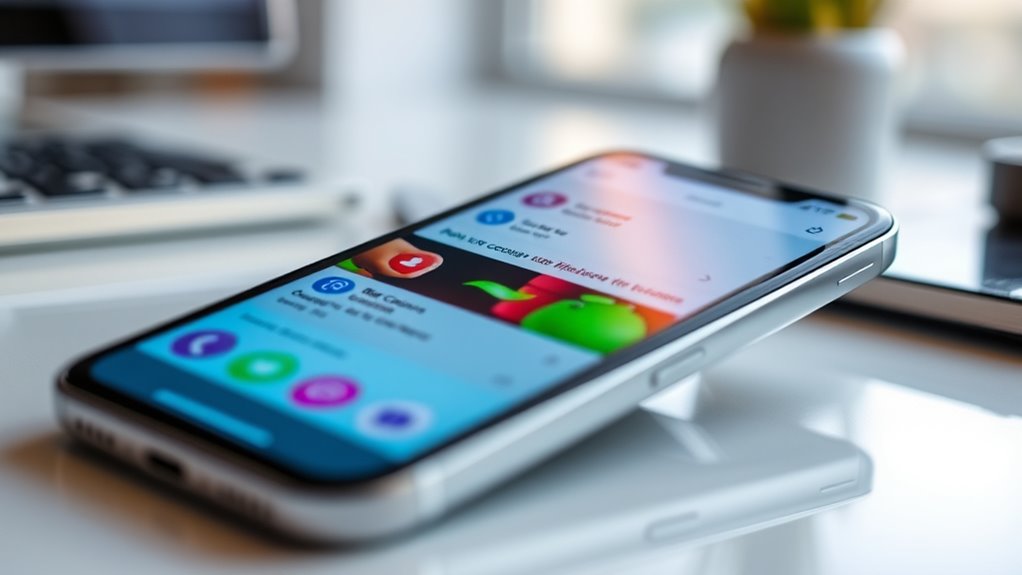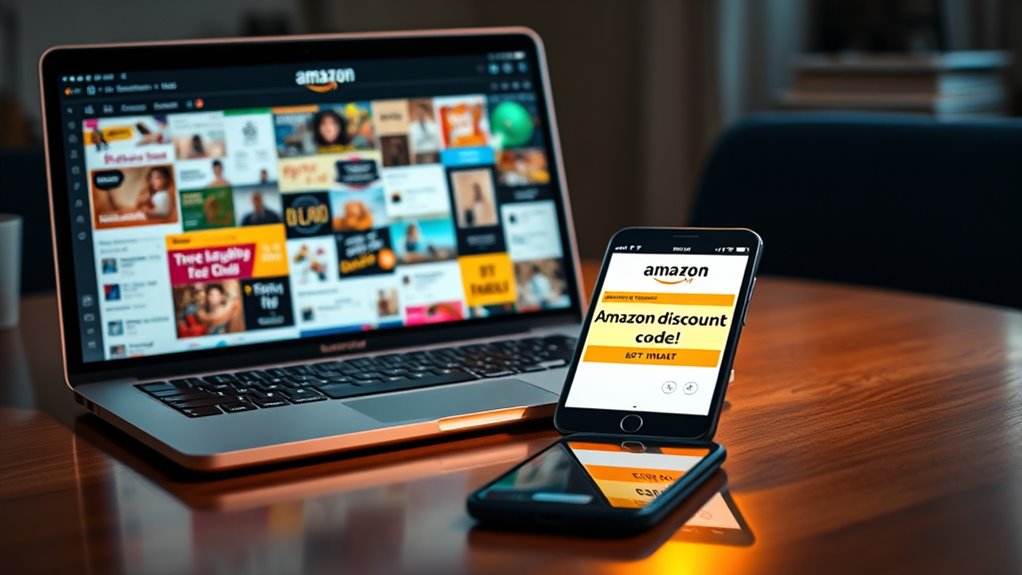Amazon limits how you can share promo codes on social media to protect its marketplace. You can’t post discount codes directly on product pages or use overly promotional language. Instead, you should generate unique URLs and share those links instead of visible codes, ensuring compliance with Amazon’s guidelines. If you stick to these rules, your promotions stay within Amazon’s boundaries. Want to find out exactly what’s allowed and how to do it right? Keep exploring the details here.
Key Takeaways
- Amazon does not promote or encourage direct sharing of promo codes on social media; sellers manage their own marketing efforts.
- Promo codes are linked to unique URLs and are not visible directly on product pages or social platforms.
- Sharing codes improperly or violating Amazon’s guidelines can lead to code invalidation or seller account issues.
- Sellers must ensure their promotion URLs are accurate and compliant with Amazon’s policies before distributing.
- Amazon monitors code usage to prevent misuse and enforce compliance with its promotional and advertising policies.

Ever wondered how sellers boost their sales and brand visibility on Amazon? One effective strategy they use involves sharing coupon codes on social media platforms like Facebook and Instagram. These promo codes are designed to attract new customers, reward loyal followers, and increase overall sales. They work by offering discounts that apply at checkout, encouraging buyers to complete their purchases. But there’s a lot more to this tactic than simply posting a code—it’s a carefully managed process with specific rules and limitations.
Sharing social media coupon codes boosts Amazon sales, attracts new customers, and rewards loyal followers through targeted discounts.
When you create a social media promo code, you do so through Amazon Seller Central, often using the Amazon Advertising Console. You can customize these codes by setting discount percentages and selecting eligible products. Once you submit your promotion for review and approval, it can go live within hours. This quick turnaround allows you to respond to marketing opportunities promptly. However, you should remember that these codes are not visible directly on product pages. Instead, they apply only at checkout, making it essential to direct your followers to the right URLs and ensure your promotion is live at the right time.
Sharing these codes requires strategic planning. You generate unique URLs for each promotion and distribute them through your social media channels. Your goal is to target specific audiences with consistent messaging that highlights the value of your discounts. But it’s important to note that Amazon itself doesn’t promote these codes; they’re solely managed by you. This means you’re responsible for marketing the promotion and ensuring it reaches the right people. Timing matters—share your codes when your promotion is active and verify your URLs beforehand to avoid any confusion or broken links.
The benefits of social media promo codes are significant. They increase your brand’s visibility on Amazon, help you engage with your followers, and give you control over how discounts are offered. You can track how well your campaigns perform, giving you insights into what works best for your audience. Plus, these codes offer flexibility—they can apply to multiple units and provide varying discount percentages, making them adaptable to different marketing strategies. Additionally, Amazon provides tools to monitor the usage and effectiveness of your promo codes, helping you optimize future campaigns.
Understanding the eligibility requirements is essential for participation, as Amazon has specific criteria to ensure only reputable sellers benefit from these promotional tools.
Frequently Asked Questions
Can I Share Amazon Coupon Codes via Email?
You can’t share Amazon coupon codes via email if you’re using Amazon’s messaging system, as it violates their terms. However, if you send codes through external email marketing, make sure recipients have consented, and avoid collecting buyer emails directly from Amazon. Use single-use or limited-use codes for better control, and always guarantee your sharing methods comply with Amazon’s policies to prevent account issues.
Are There Any Legal Issues With Sharing Coupon Codes?
Did you know that 76% of consumers use coupons to make purchase decisions? When sharing coupon codes, you might face legal issues if you violate platform policies or terms, such as resale restrictions or social media sharing rules. Always read the specific terms and conditions, avoid manipulating search rankings or reviews, and guarantee your sharing practices comply with legal and platform guidelines to prevent potential legal trouble.
How Does Amazon Track Coupon Code Usage?
Amazon tracks your coupon code usage mainly through tracking IDs assigned in Seller Central, which help identify each promotion. When customers use a code, it gets logged in order and fulfillment reports, including date and time. You can analyze this data with spreadsheets and formulas. However, Amazon doesn’t monitor external sharing on social media, so if codes leak outside your control, you’ll need manual checks to track their usage.
Can Influencers Get Special Coupon Sharing Privileges?
Imagine you’re in the 21st century, not the Renaissance, and you’re wondering if influencers get special coupon privileges. The answer is no; Amazon doesn’t give influencers unique coupon sharing rights. They must follow the same rules as everyone else. You can promote coupons via social media, but you need to adhere to Amazon’s policies. High-quality content and engagement are your best tools to maximize your earning potential within those guidelines.
What Penalties Does Amazon Impose for Unauthorized Sharing?
You risk severe penalties if you share coupon codes unauthorized on Amazon. The platform doubles your commission fees for a year, permanently bans your account, and may remove your selling privileges. You could also face financial penalties, such as fees on coupon campaigns, or account suspensions for misuse or manipulative practices. Amazon takes unauthorized sharing seriously, so always follow their rules to avoid these costly consequences.
Conclusion
Navigating Amazon’s stance on coupon code sharing is like walking a tightrope—you want to save money but don’t want to fall into trouble. By respecting their guidelines, you keep your shopping journey smooth and worry-free, much like a ship sailing steadily through calm waters. Remember, while sharing can feel like spreading joy, it’s essential to stay within the lines to avoid sinking your savings. Play it smart, and your deals will keep flowing like a gentle stream.







